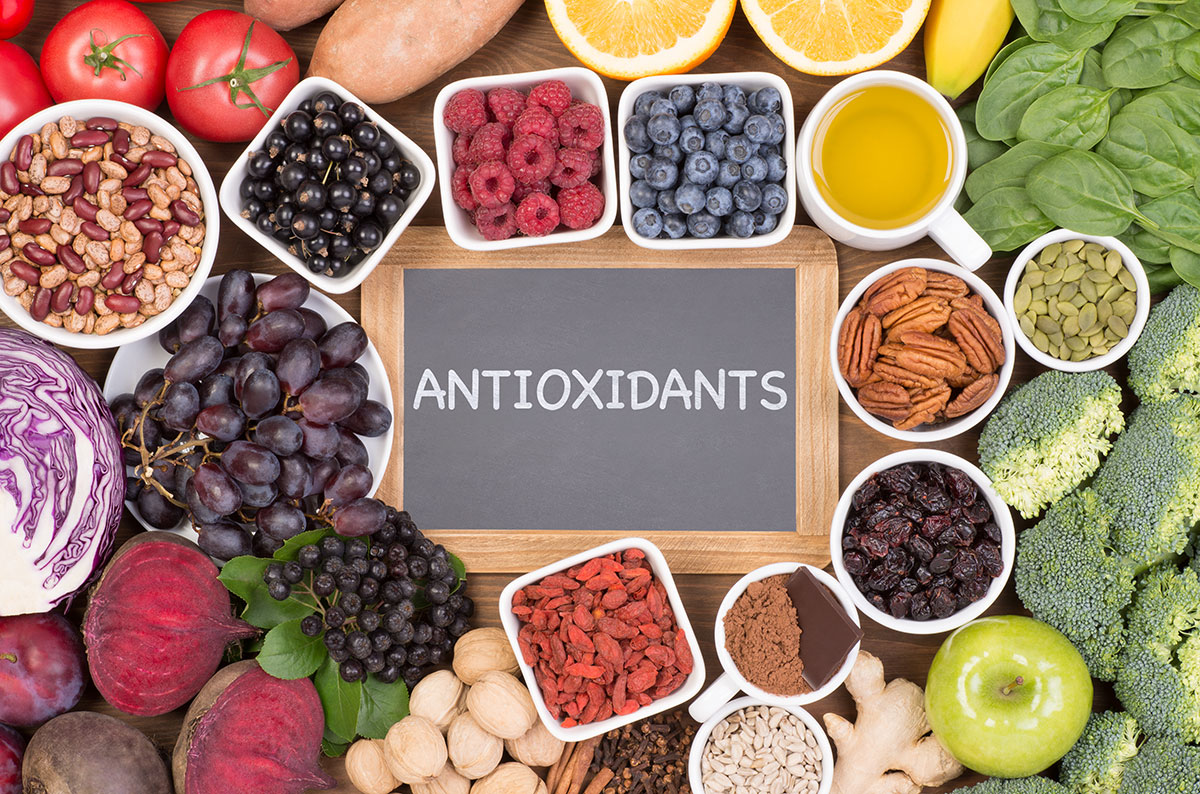Get a Free box of Gummies ($120 value) when you spend $200 or more. Now through Monday

Learn your best natural sources of antioxidants
Antioxidants play a vital role in maintaining your overall health and wellness. 1
Antioxidants are molecules that help protect cells from damage caused by free radicals. Free radicals are unstable compounds that can cause oxidative stress, potentially causing cellular damage. 1
The great news is that these mighty molecules are readily available to you naturally in fruits, vegetables, and in science-backed supplements. Examples of antioxidants include vitamin C, Carbon 60 (C60), beta-carotene, lycopene, selenium, and lutein. 2, 3
At C60 Power, we’re dedicated to helping you take back control of your health. We are passionate about educating you on how to get the most from your body.
Keep reading to learn all about antioxidants and how you can embrace the power of these powerful and healthful molecules.
Antioxidants are naturally occurring or human-made molecules that work to limit or slow cellular damage caused by free radicals. The vitamins and minerals in the foods you consume are antioxidants and your body naturally creates antioxidants. 1
We like to think of antioxidants as your friends. These molecules have the all-important job of defending against free radical damage. 1
To really understand why antioxidants matter, you need to know the facts on free radicals and oxidative stress:
Antioxidants are your number one line of defense against free radicals, acting as free radical scavengers. These smart molecules give free radicals an electron, without risk of becoming a free radical. 1
There is so much to tell you about antioxidants, that it can be easy to overwhelm you with information. So here are the key facts about antioxidants we want you to know and remember: 1, 2, 4, 7
Just as it’s important to eat a wide variety of foods, it’s equally important to get a broad source of antioxidants. Each antioxidant has a different and key role in your body.
Our suggestion – start with your favorite natural antioxidant sources and then add two more each week. Before you know it, you’ll be eating the recommended 30 different types of plant-based foods a week – your body, mind, and antioxidant levels will thank you! 3, 8, 9, 10, 11, 12
Harnessing the power of antioxidants is one of the best things you can do to limit free radical damage and oxidative stress. These lifestyle tips can help you embrace antioxidants to their fullest capabilities. 7, 13, 14, 15, 16, 17
The human body is fascinating, and the more each of us understands about how it works and functions at its best – the healthier we can be.
There aren’t any magic overnight solutions to health and wellness, but a consistent focus on healthy eating, smart supplementation, managing stress, and moving your body go a very long way in keeping you feeling and looking your best.
We applaud and support you in your healthy living and wellness journey.
To stay up-to-date with the latest from us about health, wellness, C60, and you, subscribe to our newsletter. Extra bonus – you get 10% off when you subscribe!
‡ These statements have not been evaluated by the Food and Drug Administration. These products are not intended to diagnose, treat, cure, mitigate, or prevent any disease. Individual results may vary.
[1] Lobo V, Patil A, Phatak A, Chandra N. “Free radicals, antioxidants and functional foods: Impact on human health.” Pharmacogn Rev. 2010 Jul;4(8):118-26. https://www.ncbi.nlm.nih.gov/pmc/articles/PMC3249911/
[2] Antioxidants: In Depth, National Center for Complementary and Integrative Health (Accessed May 1, 2024) https://www.nccih.nih.gov/health/antioxidants-in-depth
[3] Meissner, Morgan. “Is Carbon 60 (C60) Good for You?” Healthline.com. (Accessed May 1, 2024) https://www.healthline.com/health/carbon-60-health-effects
[4] Pham-Huy LA, He H, Pham-Huy C. “Free radicals, antioxidants in disease and health.” Int J Biomed Sci. 2008 Jun;4(2):89-96. https://www.ncbi.nlm.nih.gov/pmc/articles/PMC3614697/
[5] Cleveland Clinic. “Oxidative Stress.” (Accessed May 1, 2024) https://my.clevelandclinic.org/health/articles/oxidative-stress
[6] Sharif-Rad, Mehdi et al. “Lifestyle, Oxidative Stress, and Antioxidants: Back and Forth in the Pathophysiology of Chronic Diseases.” Frontier in Physiology. 2020 Jul;11. https://www.frontiersin.org/journals/physiology/articles/10.3389/fphys.2020.00694/full
[7] Arnarson, Alti. “Antioxidants Explained in Simple Terms.” Healthline.com (Accessed May 1, 2024) https://www.healthline.com/nutrition/antioxidants-explained
[8] Harvard T.H. Chan School of Public Health. “Antioxidants.” (Accessed May 1, 2024) https://www.hsph.harvard.edu/nutritionsource/antioxidants/
[9] Better Health Channel. “Antioxidants.” (Accessed May 1, 2024) https://www.betterhealth.vic.gov.au/health/healthyliving/antioxidants
[10] Harvard T.H. Chan School of Public Health. “Manganese.” (Accessed May 1, 2024) https://www.hsph.harvard.edu/nutritionsource/manganese/
[11] Robertson, Ruairi. “Omega-3-6-9 Fatty Acids: A Complete Overview.” Healthline.com (Accessed May 1, 2024) https://www.healthline.com/nutrition/omega-3-6-9-overview
[12] Jones, Paul. “Why should you eat 30 plants a week?” Zoe.com (Accessed May 2, 2024) https://zoe.com/learn/30-plants-per-week
[13] Jiang S, Liu H, Li C. “Dietary Regulation of Oxidative Stress in Chronic Metabolic Diseases.” Foods. 2021 Aug 11;10(8):1854. https://www.ncbi.nlm.nih.gov/pmc/articles/PMC8391153/
[14] Simioni C. et al. “Oxidative stress: role of physical exercise and antioxidant nutraceuticals in adulthood and aging.” Oncotarget. 2018 Mar 30;9(24):17181-17198. https://www.ncbi.nlm.nih.gov/pmc/articles/PMC5908316/
[15] Dalleck, Lance C. et al. “Free Radicals, Antioxidants and Exercise: A New Perspective.” ACE. (Accessed May 2, 2024) https://www.acefitness.org/continuing-education/prosource/november-2015/5688/free-radicals-antioxidants-and-exercise-a-new-perspective/
[16] Poljsak B. “Strategies for reducing or preventing the generation of oxidative stress.” Oxid Med Cell Longev. 2011;2011:194586. https://www.ncbi.nlm.nih.gov/pmc/articles/PMC3236599/
[17] Kim, Eunkyoung et al. “Association of acute psychosocial stress with oxidative stress: Evidence from serum analysis.” Redox Biology. 2021 Nov 47. https://www.sciencedirect.com/science/article/pii/S2213231721002974

Ken Swartz, MS is the co-founder, Chairman Emeritus, and former Chief Science Officer at C60 Power, a health and wellness company committed to delivering the highest quality Carbon 60 products available. Ken earned a Master of Science degree from the University of Colorado at Denver and a Bachelor of Science in Economics from Arizona State University.’